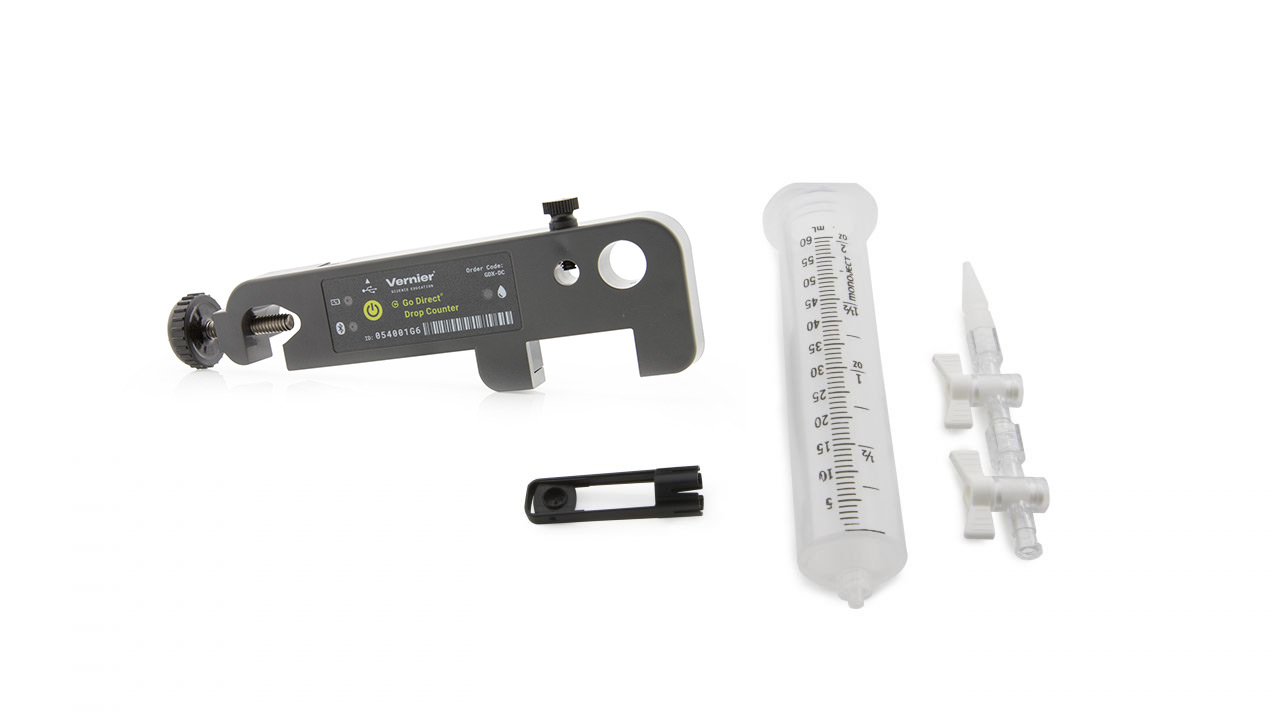Troubleshooting
Press the power button on the sensor to turn it on. Connect your sensor as described in the Getting Started instructions for your device. (The green LED will flash to indicate the sensor is connected.)
- Primary Test: If your Drop Counter is not counting drops, check the alignment of the sensor beneath the tip of the reservoir or buret. Adjust the Reagent Reservoir so that the drop passes closer to the center of the opening.
- Secondary Test: The Drop Counter works best when the drops fall at a rate of 2 seconds per drop or slower.
If you cannot get it to count drops, use your finger or a pen to break the beam and see if this registers in the software.
Additional Troubleshooting
- Do you have a drop counter?
- How can I improve my results with the Drop Counter?
- Why is the Drop Counter calibration lost?
- I want to use my drop counter to get a graph of drops per second.
- Go Direct sensor does not connect to LabQuest 2 via Bluetooth.
- Troubleshooting Bluetooth Connections with Go Direct Sensors
- What can I do if a Go Direct sensor's Bluetooth LED flashes red and green when I try to connect to it and the connection fails?
- Will my device work with Go Direct Sensors via Bluetooth?
- How do I know if my LabQuest will work with Go Direct Sensors and Go Wireless devices?
Specifications
- Accurate drop counting at rates up to 6 drops/s
- Dimensions:
⚬ Opening for drops: 3 cm
⚬ Openings for sensors (diameter): 7 mm and 13 mm
⚬ Ring stand opening: 16 mm
⚬ Total length: 15.5 cm, width: 4.5 cm, height: 1.8 cm
⚬ Distance from center of ring stand opening to center of drop opening (ideal): 10.5 cm
⚬ Distance from center of ring stand opening to center of sensor opening (ideal): 12 cm - Connections:
⚬ Wireless: Bluetooth® v4.2 (wireless range 30 m unobstructed)
⚬ Wired: USB 2.0 full speed - Battery: 300 mA Li-Poly
⚬ Battery Life (single, full charge): ~24 hours continuous data collection
⚬ Battery Life (lifetime): 2 – 5 years (typical)
Calibration
Calibrate? Not always. The sensor is set to use a default calibration of 28 drops/mL. The sensor can be calibrated following the instructions below.
- Place a 10 mL graduated cylinder below the slot of the Drop Counter.
- Fill the reagent reservoir about 3/4 full with the titrant solution.
- Choose to calibrate the Drop Counter in your data-collection program.
- Open the bottom 2-way (on-off) valve to begin releasing drops through the Drop Counter.
- Release drops until there are 9-10 mL of liquid in the graduated cylinder.
- Close the bottom valve to stop the drops.
- Type the exact volume, to the nearest 0.1 mL, of liquid in the graduated cylinder in the Volume (mL) box of the Calibrate drops dialog box.
- Choose to stop the calibration routine of your program.
- The number of drops/mL will be displayed.
- You can now continue with the titration.
Note: You may manually enter a drops/mL ratio that was done from a previous calibration.
Battery Troubleshooting
- If the sensor can be turned on when connected by USB but not when disconnected from USB, the battery either needs charging or has reached its end of life and can no longer hold a charge.
⚬ First, try charging the sensor for several hours. - If the sensor still won’t turn on when disconnected from USB, try swapping the battery with a working sensor to see if the problem follows the battery or stays with the sensor.
⚬ If the problem stays with the sensor, the battery is probably not the issue.
⚬ If the problem follows the battery, the battery has likely reached its end of life. - If you intend to use this sensor wirelessly, its battery will need replacing.
Go Direct® 300 mAh Replacement Battery (GDX-BAT-300) - See How do I remove or replace a Go Direct battery? for more information (including a video).
Rechargeable batteries are covered by a one-year warranty.
Batteries should last two to five years in typical use.
Related Products
- Micro USB to USB-C Cable (CB-USB-C-MICRO)
- Go Direct® Charge Station (GDX-CRG)
- Precision Volume Dispenser (DC-DISP)
- Stir Station (STIR)
- Go Direct® pH Sensor (GDX-PH)
- Go Direct® ORP Sensor (GDX-ORP)
- Go Direct® Conductivity Probe (GDX-CON)
- Drop Counter (VDC-BTD)
Replacement Parts
- Go Direct® 300 mAh Replacement Battery (GDX-BAT-300)
- Micro USB Cable (CB-USB-MICRO)
- Microstirrer (MSTIR)
- Reagent Reservoir, 2 Valves, and Tip (VDC-RR)
- Stopper Stem (PS-STEM)
- Plastic 2-Way Valve (PS-2WAY)

